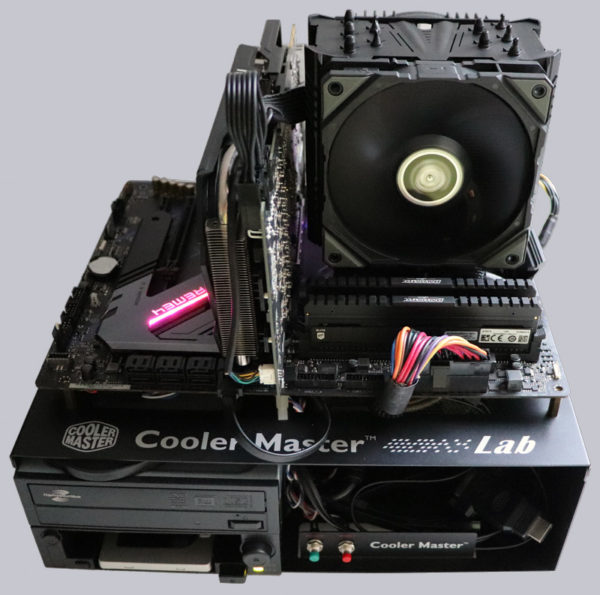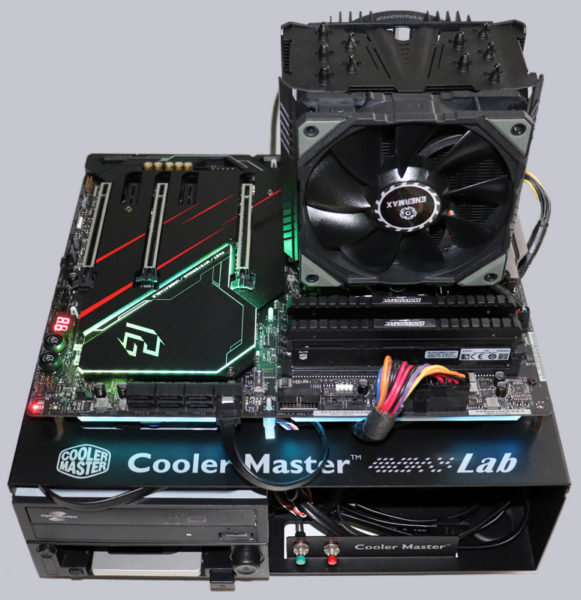
Now we come to another important part of the review: The performance!
AMD Ryzen 3000 Testsystem …
The following PC structure was used as AMD test system:
| AMD Ryzen 3000 Socket AM4 PC | |
| AMD Motherboard | ASRock X570 Extreme4 |
| CPU | AMD Ryzen 7 3800X |
| Cooler | Enermax ETS-T50 AXE |
| Thermal paste | ARCTIC MX4 |
| Video card | MSI Radeon R9 280 |
| SSD | Crucial MX200 |
| PSU | Cooler Master Silent Pro M 600W |
| Case | Cooler Master Testbench v1.0 |
| Operating system | Windows 10 Pro 64 Bit |
Intel LGA1151 Testsystem …
The following PC structure was used as Intel test system:
| Intel 9th Gen LGA1151-2 PC | |
| Intel Motherboard | ASRock Z390 Phantom Gaming X |
| CPU | Intel Core i9-9900K CPU |
| Cooler | Enermax ETS-T50 AXE |
| Thermal paste | ARCTIC MX4 |
| SSD | Crucial MX200 |
| PSU | Cooler Master Silent Pro M 600W |
| Case | Cooler Master Testbench v1.0 |
| Operating system | Windows 10 Pro 64 Bit |
With Memtest86 the stability was tested and SiSoft Sandra Lite 2017 and AIDA64 were used as benchmark programs. The latest versions of SiSoftware Sandra and AIDA64 are available for download on our server and can be downloaded here at high speed. There you can also find the CPU-Z download.
Let’s start with the AMD system.
AMD Ryzen DDR4 benchmark with SPD values …
First the memory modules are tested with default BLCK with SPD values, whereby the SPD values were given by the manufacturer in the SPD IC and are read out over the mainboard. With default BLCK the timings with the autosettings from the SPD EEPROM were set to 16-18-18-38 2T (CAS-TRCD-TRP-TRAS).
Here is a screenshot of CPU-Z 1.89 at 1336.8 MHz / DDR4-4000 and 20-19-19-43 1T with 1.20 Volt:
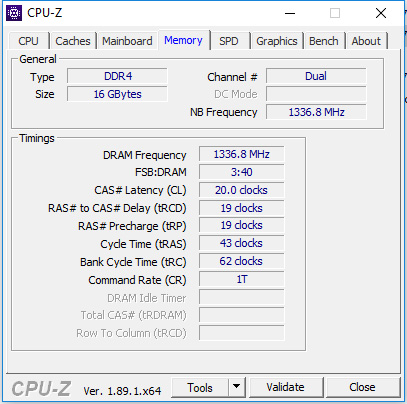
And the following timings shows CPU-Z for selection.
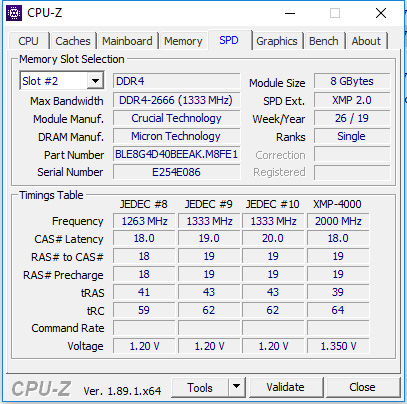
Here is the result of the SiSoftware Sandra benchmark tests:
| Default frequency | Timing | RAM voltage | RAM bandwidth integer B/F AVX512/512 | Memory Transaction throughput | Memory Latency time |
| 1336.8 MHz | SPD 20-19-19-43 | 1.20 Volt | 28.57 GB/s | 5.5 MTPS | 40.9 ns |
Here are the corresponding screenshots …
SiSoft Sandra Lite 2017 memory bandwidth.

SiSoft Sandra Lite 2017 memory transaction throughput.

SiSoft Sandra Lite 2017 memory latency.

Here is the result of the AIDA64 memory benchmark tests:
| Default frequency | Timing | Memory voltage | Memory Read throughput | Memory write throughput |
| 1336.8 MHz | SPD 20-19-19-43 | 1.20 Volt | 37102 MB/s | 21331 MB/s |
Here are the corresponding screenshots …
AIDA64 Memory Read Throughput Benchmark.
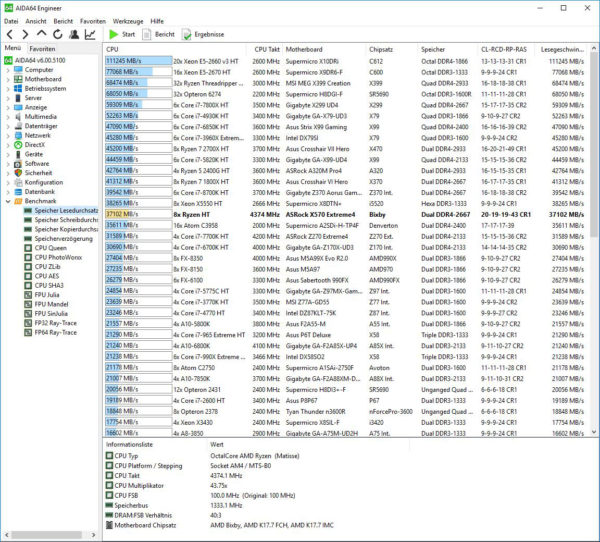
AIDA64 memory write throughput benchmark.
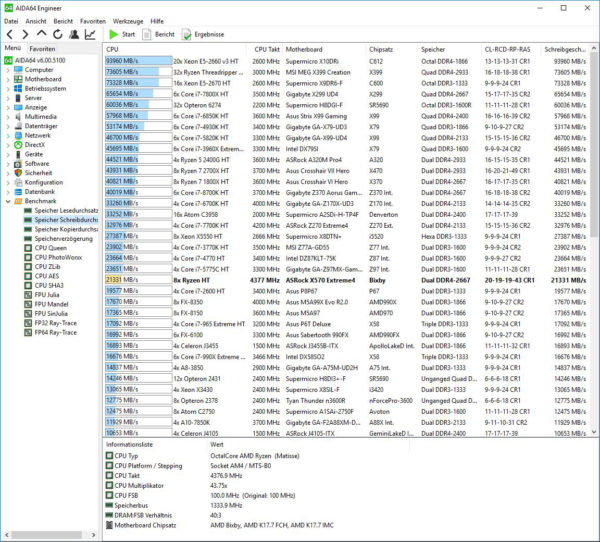
AMD DDR4 benchmark with XMP settings …
Now the memory modules are tested with XMP values, where the XMP values were specified by the manufacturer in the XMP profile IC and can be loaded via the motherboard. The timings from the XMP EEPROM were set to DDR4-4000 18-19-19-39 1T (CAS-TRCD-TRP-TRAS) with the AMD test system.
Here is a screenshot of CPU-Z 1.89 at 2005.3 MHz / DDR4-4000 and 18-19-19-39 1T with 1.35 Volt:
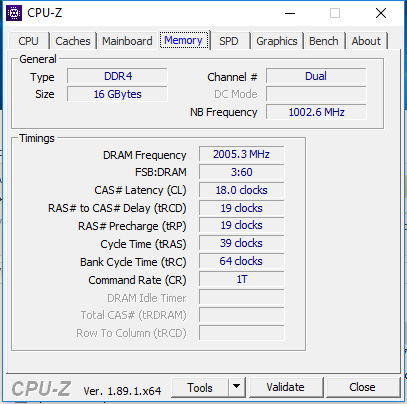
Here is the result of the SiSoftware Sandra benchmark tests:
| Default frequency | Timing | RAM voltage | RAM bandwidth integer B/F AVX512/512 | Memory Transaction throughput | Memory Latency time |
| 2005,3 MHz | XMP 18-19-19-39 | 1,35 Volt | 39,28 GB/s | 6,1MTPS | 36,1 ns |
Here are the corresponding screenshots …
SiSoft Sandra Lite 2017 memory bandwidth.

SiSoft Sandra Lite 2017 memory transaction throughput.

SiSoft Sandra Lite 2017 memory latency.

Here is the result of the AIDA64 memory benchmark tests:
| Default frequency | Timing | Memory voltage | Memory Read throughput | Memory write throughput |
| 2005.3 MHz | XMP 18-19-19-39 | 1.35 Volt | 49003 MB/s | 28799 MB/s |
Here are the corresponding screenshots …
AIDA64 Memory Read Throughput Benchmark.
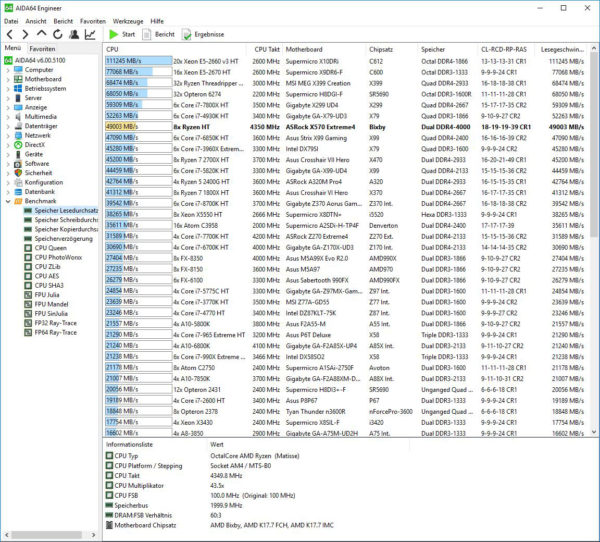
AIDA64 memory write throughput benchmark.
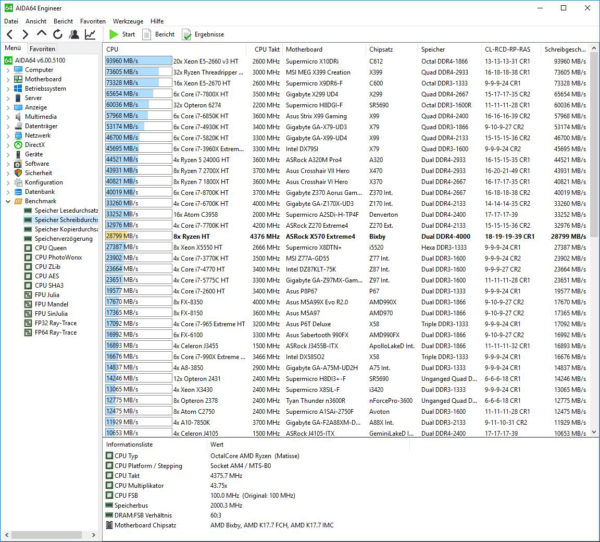
AMD DDR4 OC with 1.35 Volt …
Now the maximum possible frequency of the memory modules at default 1.35 Volt is determined. For this the memory clock is increased in small steps with a fixed memory timing of 18-19-19-39 1T and 1.35V voltage, as long as the detailed Memtest86 test is still running without errors. The rather long test time ensures that this frequency is really stable for the modules.
The highest possible frequency with 15-15-15-36 2T timings and 1.20V was approx. 2200.3 MHz, which corresponds approximately to DDR4-4400.
Here is a screenshot of CPU-Z 1.89 at 2200.3 MHz / DDR4-4400 and 18-19-19-39 1T with 1.35 Volt:
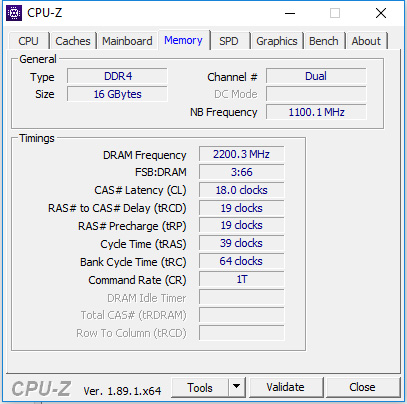
In order not to lose the overview, we have only included the reading test of AIDA64. Here is the result of the AIDA64 memory benchmark test:
| Default frequency | Timing | Memory voltage | Memory Read throughput |
| 2200.3 MHz | 18-19-19-39 | 1.35 Volt | 50408 MB/s |
Here is the corresponding screenshot …
AIDA64 Memory Read Throughput Benchmark.
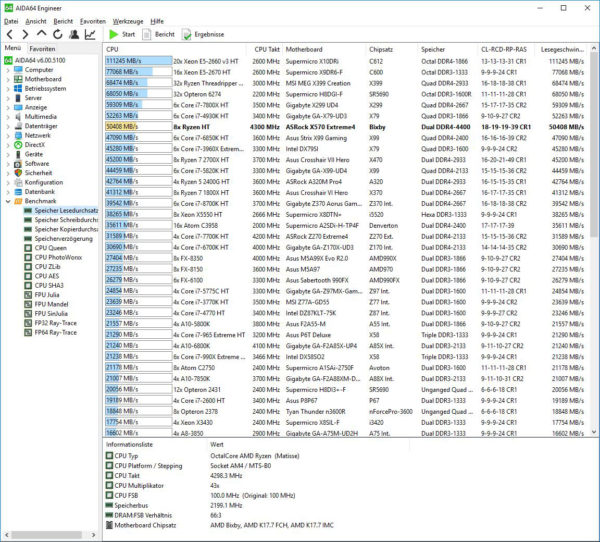
AMD DDR4 OC with 1.50 Volt …
The highest possible frequency is then determined at 18-19-19-39 1T with increased voltage. Since overclocking is outside the specifications anyway, we decided to use an OC voltage of 1.50 volts to overclock the memory a little higher.
With an increased memory voltage of 1.50 Volt the DDR4 memory modules could be overclocked a little bit more at 18-19-19-39 1T timings, so that we are operated on 2301.1 MHz, which corresponds approximately to DDR4-4600. Officially, however, Micron only specifies a DDR4 voltage of 1.35 Volt, without losing the warranty!
Here is a screenshot of CPU-Z 1.89 at 2301.1 MHz / DDR4-4600 and 18-19-19-39 1T with 1.50 Volt:
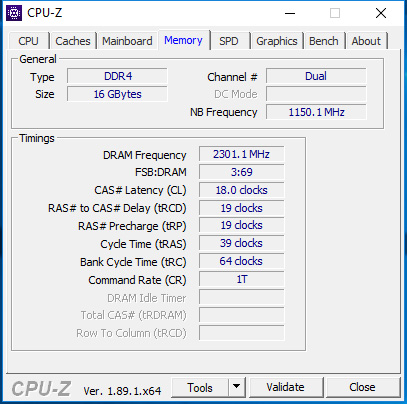
Here is the result of the AIDA64 memory benchmark test:
| Default frequency | Timing | Memory voltage | Memory Read throughput |
| 2301.1 MHz | 18-19-19-39 | 1.50 Volt | 51007 MB/s |
Here is the corresponding screenshot …
AIDA64 Memory Read Throughput Benchmark.
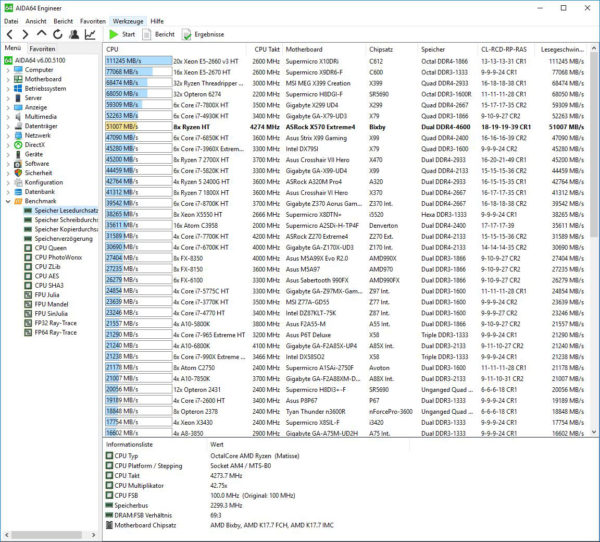
AMD Infinity Fabric …
With these measured values you should note, however, that AMD officially supports DDR4-3600 with the latest Ryzen 3000 CPU (see AMD Ryzen 7 3700 Test) and activates a divider at clock rates above, which reduces the so-called Infinity Fabric Bus to the memory controller from 1:1 to a slower divider. Thus the RAM clocks really fast, but the possible IF bandwidth to the CPU is significantly reduced. Of course the memory performance suffers from this, so that you should definitely consider with which clocking you should operate your memory on AMD systems. But since this topic is not explained in two sentences and with two benchmarks, we will certainly publish an article about it soon.
Intel DDR4 benchmark with XMP values …
In order to at least get a clue how AMD vs. Intel behaves in terms of memory performance, we tested the Ballistix DDR4-4000 modules on an ASRock Z390 Phantom Gaming X motherboard with Intel Core i9-9900K 9th Gen CPU.
The memory modules of the Intel 9th Generation PC are also tested with XMP values, whereby the XMP values were specified by the manufacturer in the XMP profile IC and can be loaded via the mainboard. The timings from the XMP EEPROM were set to DDR4-4000 18-19-19-39 1T (CAS-TRCD-TRP-TRAS) by the Intel PC.
Here is a screenshot of CPU-Z 1.89 at 2000.1 MHz / DDR4-4000 and 18-19-19-39 2T with 1.35 Volt:
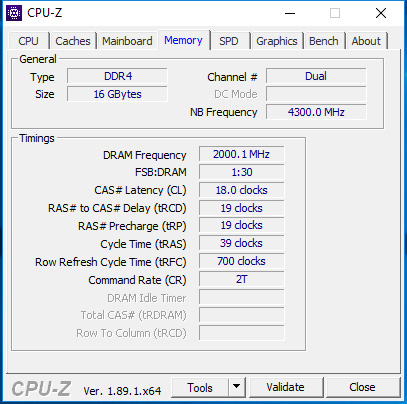
Here is the result of the AIDA64 memory benchmark test:
| Default frequency | Timing | Memory voltage | Memory Read throughput |
| 2000.1 MHz | 18-19-19-39 | 1.35 Volt | 54736 MB/s |
Here is the corresponding screenshot …
AIDA64 Memory Read Throughput Benchmark.
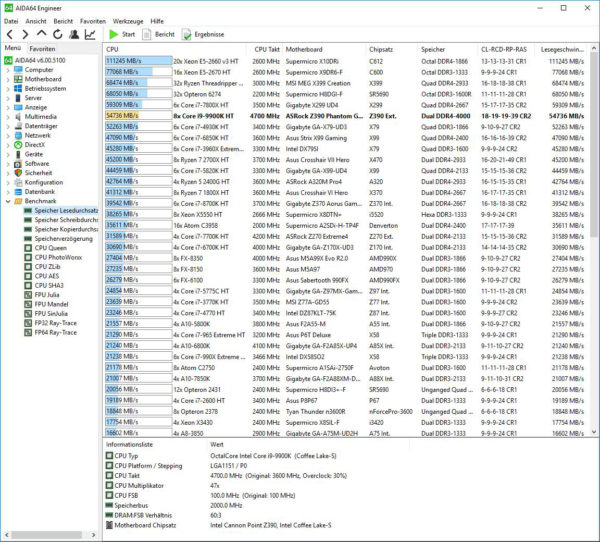
As you can see very well, the bandwidth RAM reading throughput of the Intel system at DDR4-4000 clocking is significantly higher than the AMD Ryzen 3000 system, but as mentioned before, this is due to the AMD Infinity Fabric. How to achieve more performance with the AMD Ryzen 3000 system will soon be shown in an OCinside.de workshop. IF divider or not – let’s note that the new Ballistix Elite memory modules are designed for both AMD and Intel systems and achieve very high performance on both systems.
The heat dissipation is also positive, because even under heavy use, the internal temperature sensors have only displayed approx. 33.25°C.
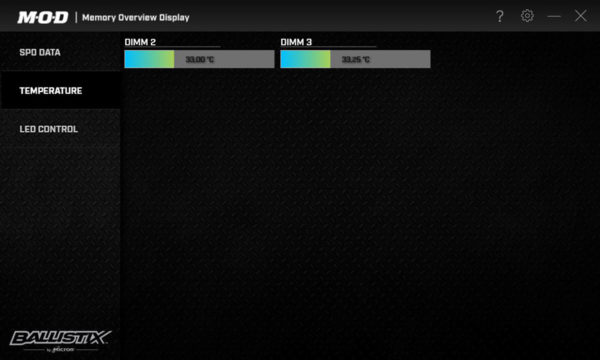
Also our thermal imaging camera occupies this low temperature with an approximate thermal image temperature of only 33°C.
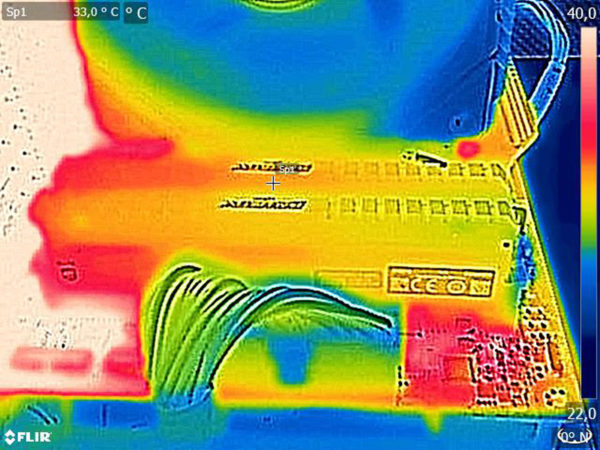
Ballistix Elite 16GB DDR4 Kit 2x 8GB DDR4-4000 Conclusion and overall impression …


